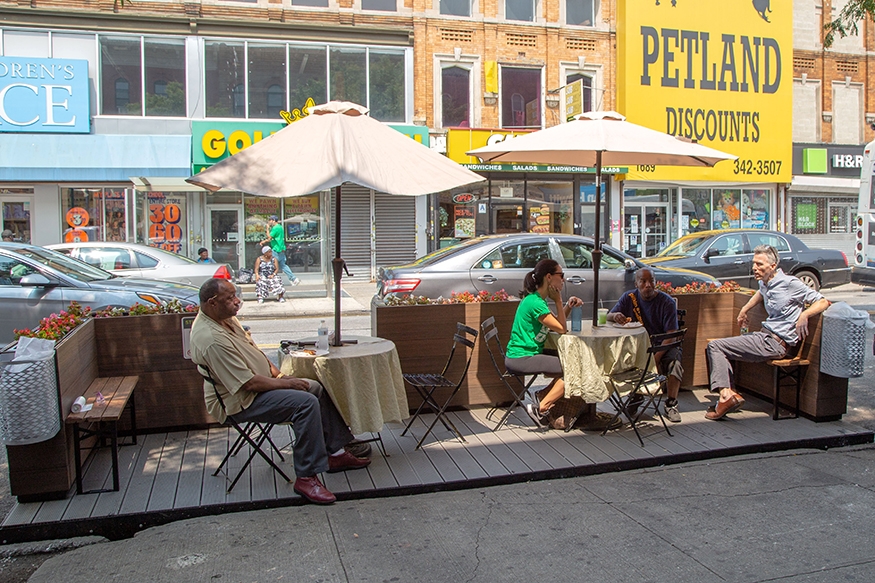
Clear Path
City regulations mandate that objects on sidewalks leave an unobstructed clear path for pedestrian flow. An 8-foot clear path must be maintained in areas with high pedestrian traffic, and a minimum 5-foot clear path must be maintained in areas with low pedestrian traffic. DOT may require up to 15 feet in locations with particularly high pedestrian volumes. Exceptions may be approved by DOT on a case-by-case basis. Most street furniture should be placed 18 inches from the curb to allow for motor vehicle access. To accommodate pedestrians with vision disabilities, the lowest edge of any ground-level protruding object should be no more than 2.25 feet above the sidewalk, and the lowest edge of any protruding object suspended above the sidewalk should be a minimum height of 7 feet.
Clutter
DOT generally discourages the installation of street furniture and other permanent objects on streets where they may restrict pedestrian circulation and degrade the visual quality of the street.
Design
Light poles, WalkNYC Wayfinding signs, seating, bike racks, bus shelters, and other fixed elements play a supporting role on New York City streets. Consistent design of those varied elements is an important consideration in their selection and siting.
Furniture should be designed to accommodate as wide a range of potential users as possible. Considerations include interface height, amount of force that must be applied to buttons or movable objects, color schemes and level of contrast with surrounding materials, and adjacent clear path.
Property Lines
Property owners must determine the exact locations of their property lines by consulting the surveys provided to them upon purchase of their properties or by retaining licensed surveyors to prepare such surveys. While the metes and bounds of private properties are clearly described in deeds and other real property documents, existing outdoor structures may not be consistent with these boundaries.
Resiliency
Street furniture and other permanent objects should be constructed using resilient materials that can withstand periodic temporary inundation by both fresh and salt water, particularly when located in flood-prone areas. Designers should focus particular attention on the elevation and protection of critical electrical components.
Revocable Consents
The city grants a revocable consent to construct and use certain structures on, over, or under its inalienable property—in this case, city roadways and sidewalks. The city retains its right to revoke this consent at any time, and PDC review may be required for revocable consents. Visit the Revocable Consents web page for more information.
Security Structures
Security structures are fixed objects, such as bollards, installed around the perimeter of a building or public space to reduce the risk of vehicle-based attacks and blast impacts from vehicle-born explosives. A property owner who wishes to install security structures must apply for a revocable consent from DOT. The application is forwarded to the NYPD Counterterrorism Division, which reviews security-related information provided by the property owner. If the NYPD determines that security structures are necessary, it works with the property owner’s architect/engineer to develop a conceptual plan of an effective security perimeter.
DOT then works with the owner and architect/engineer to develop plans that will provide the security perimeter required by NYPD and will fit in with all other structures that are already in, under, and above the affected streets. DOT then coordinates an expedited interagency review, including submission to PDC or LPC, of the plans. Plans are reviewed on a case-by-case basis to confirm that the structures are necessary and effective, minimize impact on pedestrian and vehicular traffic, and are aesthetically appropriate.
Siting Guidelines
Furniture Siting Guidelines diagram [PDF]
See the Furniture Siting Guidelines diagram [PDF] for information on street furniture siting.


